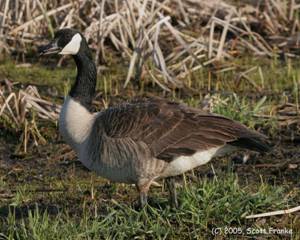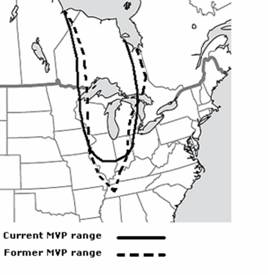

Status/Protection
- Global Rank: G5 Key to global and state ranks
- State Rank: S5B
- WBCI Priority: WFOWL
Population Information
- Waterfowl Breeding Population and Habitat Survey: Slight downward trend for MVP of 1% per year on average (1997-2006; USFWS 2006).
Life History
- Breeding Range: Northern Ontario, primarily in the Hudson Bay lowlands west of James Bay.
- Breeding Habitat: Tundra/marsh complexes or muskeg along the coast of Hudson Bay and inland to boreal forest bogs (Bellrose 1980, Abraham et al. 1998).
- Nest: Scrape on drier, slightly elevated site, usually near water margin or on sedge/sphagnum hummocks surrounded by low wet ground or marsh (Mowbray et al. 2002).
- Nesting Dates: Does not nest in Wisconsin; Eggs: mid-May on Hudson Bay breeding areas (Abraham et al. 1998).
- Foraging: Surface dips and dabbles for aquatic vegetation on water; grazes grasses, sedges, or other green monocots and feeds on waste grain on land.
- Migrant Status: Short-distance migrant
- Habitat use during Migration: Inland Open Water, Great Lakes Open Water, Row Crop, Small Grains, Hay, Pastures as well as urban and suburban park landscapes, Northern Sedge Meadow and Marsh, Southern Sedge Meadow and Marsh, and Wild Rice.
- Arrival Dates: mid-September in fall
- Departure Dates: late December or early January in fall, depending on weather conditions. However, recent warm winters have allowed MVP geese to winter in southern Wisconsin.
- Winter Range: Traditionally southern Illinois, Indiana, western Kentucky, and Tennessee; however, in recent years MVP geese rarely move farther south than central Illinois.
- Winter Habitat: Similar to migration habitat.
Habitat Selection
The Mississippi Valley Population (MVP) of Canada Goose breeds in sedge and shrub fen habitats of northern Ontario and northeast Manitoba where nests are located on high hummocks, islands in ponds and streams, and beach ridges (Bruggink et al. 1994, Abraham et al. 2001). Brood habitat in coastal areas consists of intertidal salt marshes, supratidal marshes, and freshwater sedge fens (Bruggink et al. 1994) but is not well documented in far interior areas (Raveling and Lumsden 1977). Grasses, sedges (Carex spp.), and horsetails (Equisetum spp.) are the primary foods early in the breeding cycle and are supplemented with insect larvae at the onset of egg laying (Gates 1989).
MVP geese are present in Wisconsin only in the fall, winter, and spring months. Fall migrant MVP geese in Wisconsin use lakes and wetlands as well as corn fields and other agricultural areas from October to December (Gates et al. 2001). Use of wheat stubble, clover/alfalfa, and other forage can be high, especially during early fall. Use of agricultural areas prior to crop harvest has led to crop damage, resulting in the development of a special crop damage program and Canada goose control permits in the Horicon zone. Because of the abundance of waste grain, food is not a limiting factor for MVP geese in Wisconsin; however, water areas free from hunting or other disturbance may be limiting (Coluccy et al. 2006). Although MVP geese also feed in corn fields during spring migration, other food sources become increasingly important in providing the proteins and other nutrients required for breeding activities (Moser and Tacha 1988). Particularly during the months of February and March, geese incorporate more forage, wild seeds, tubers, roots, and stolons into their diet in preparation for the breeding season.
Habitat Availability
MVP geese traditionally migrated into Wisconsin in mid to late September and concentrated in south-central Wisconsin, particularly at Horicon Marsh. In the 1970s, up to 80% of the MVP Canada Goose winter population (250,000-300,000 birds) stopped at Horicon and surrounding areas (Miller 1998). This region remains their primary fall and wintering area today, although concentrations of giant Canada Geese and available habitat may be causing shifts from traditional managed staging areas (Abraham et al. 1998) to non-managed areas on private lands. The increasing number of urban impoundments and residential developments around lakes and ponds has provided an abundance of protected roost sites outside of government-managed refuges. Moreover, recent changes in agricultural practices have resulted in increased food availability for staging and wintering geese. For instance, the acreage of corn and wheat stubble has increased significantly in recent years and more waste grain is now available on conservation tilled fields (Abraham et al. 1998).
Because of their more complex dietary needs in the spring, habitat considerations may be more important during this time of year. Gates et al. (2001) raised the concern that the recent increases in goose-use-days in east-central Wisconsin in the fall and winter could reduce the availability of corn that geese need to deposit large lipid reserves during spring staging. Small wetlands and associated lowland pastures in east-central Wisconsin also provide important spring staging areas and may be limiting in this area (Caithamer 1989, Wheeler et al. 1998).
Population Concerns
MVP Canada Geese are a popular game species within Wisconsin and throughout their range. Native American people harvest approximately 33,000 MVP geese annually in northern Ontario as part of a spring subsistence hunt. Total MVP fall hunting harvest has ranged from approximately 130,000 to 230,000. The harvest, harvest rate and spring population of MVP geese are monitored annually to adjust hunting regulations and maintain a spring breeding population of 375,000 (+/-50,000). Since 1989, MVP Canada Geese have been monitored by aerial breeding surveys conducted in northern Ontario. Over this 18-year period, breeding population estimates have shown modest fluctuations and no statistically significant trends. The population has averaged 365,000 individuals with a range from 236,000 to 494,000. However, these estimates do not include the non-breeding adults present on the coast each spring.
Population estimates from the non-breeding season have been less consistent. During the twenty year period of the Mississippi Flyway December goose surveys, MVP populations fluctuated from a low of 251,000 in 1981 to more than one million in 1989. After 1997, the December goose counts in the Mississippi Flyway were eliminated because of the difficulty in separating the populations (i.e., Eastern Prairie Population, MVP, Southern James Bay Population, Giants). The December goose counts, band recoveries and flyway-wide Midwinter Waterfowl counts still conducted each January have documented that MVP geese in Wisconsin have increased their length of stay and their statewide distribution has expanded.
The most significant long-term threat for the Mississippi Valley Canada Goose population is likely breeding habitat degradation from Snow Goose populations. Until the late 1970s, the only major overlap between MVP geese and Snow Geese occurred in the immediate Cape Henrietta Maria region. The Snow Goose colony in this area quadrupled between 1979 and 1996 (to over 200,000 breeding pairs) and has consequently degraded important MVP nesting and brood-rearing habitats. It is not known whether these areas will continue to support current MVP numbers.
Recommended Management
State and provincial wildlife management agencies within the MVP range should monitor land use and adaptively manage public lands based on valid research and/or unique local circumstances. In Wisconsin, shallow wetland habitats are important as spring staging areas and should be conservation priorities. Annual changes in hunting regulations relative to changes in breeding population will continue to be adjusted to achieve appropriate harvest rates. It is recommended that the Mississippi Flyway Council, a partnership of 17 states and provinces, continue to oversee these management decisions. As a member of this group, the state of Wisconsin contributes to the funding of spring breeding surveys and breeding ground research and cooperates on harvest monitoring and management.
Research Needs
The Mississippi Flyway Council MVP management plan has identified these research needs for the MVP:
High Priority
- Refine current methods for estimating MVP harvest in all relevant states and provinces, in order to assess effectiveness of the harvest strategy.
- Evaluate the current harvest strategy (i.e. the 2002 change), including the determination of current band reporting rates and survival rates for recent years.
Medium Priority
- Monitor habitat use, availability and diets on breeding areas, specifically 1) far interior areas need assessment; and 2) foods consumed in coastal habitats need to be determined to assess the risk of Snow Goose expansion.
- Refine estimate of non-retrieved hunting loss.
- Continue to evaluate the effects of spring phenology on reproduction.
- Determine the distribution and abundance of molt migrant giant Canada Geese on MVP summer range and their interactions with MVP breeding geese.
- Estimate Native harvest of MVP geese.
- Determine the pattern and change in distribution of MVP geese from September through April over the past decade and the timing of migration.
- Determine the impact of Snow Goose abundance and distribution on MVP migrations and winter distribution
Low Category
- Improve estimates of the number and distribution of non-breeding MVP geese during the spring survey.
- Estimate age-specific breeding propensity (e.g., brood patch).
- Evaluate potential impact of extended (i.e., late winter) seasons on nutrient acquisition.
- Resolve issues regarding Eastern Prairie Population boundaries, including an investigation of the Manitoba portion of MVP range (e.g., either band and or fly transects there).
- Refine surveys and analyses to reliably estimate annual spring population size and estimate production.
Information Sources
- Cornell Lab of Ornithology species account: http://www.birds.cornell.edu/AllAboutBirds/BirdGuide/Canada_Goose.html
- Jahn, L.R. and R.A. Hunt. 1964. Duck and coot ecology and management in Wisconsin. Technical Bulletin (33):1-212. Wisconsin Department of Natural Resources, Madison.
- Temple, S.A., J.R. Cary, and R. Rolley. 1997. Wisconsin Birds: A Seasonal and Geographic Guide. Wisconsin Society of Ornithology and Wisconsin Department of Natural Resources, Madison, WI.
- Upper Mississippi River Great Lakes Joint Venture Implementation Plan: http://www.fws.gov/midwest/NAWMP/documents/WaterfowlManagementPlan.pdf
- Waterfowl Population Status report: http://www.fws.gov/migratorybirds/reports/status06/waterfowl%20status%202006.pdf
- Wisconsin Department of Natural Resources (WDNR). 1992. Upper Mississippi River and Great Lakes region joint venture – Wisconsin plan. Madison, WI.
References
- Abraham, K., J. Bergquist, R. Pritchert, J. Leafloor, M. Hill, M. Hartman, E. Flegler, R. Marshalla, E. Warr, D. Humburg, P. David, S. Kelly, D. Orr, and F. Bowers. 1998. Management plan for the Mississippi valley population of Canada geese, 1997-2002. Mississippi Valley Population Committee of the Mississippi Flyway Technical Section.
- Abraham, K.F., R.L. Jefferies, R.K. Ross and J.O. Leafloor. 1998. Snow geese in Polar Bear Provincial Park: Implications of a trophic cascade. Pages 153-160 in Proceedings of the Parks Research Forum for Ontario. K. Van Osch, editor.
- Abraham, K.F., L.R. Walton, A.P. Jano, and J.O. Leafloor. 2001. Breeding ground studies of Mississippi Valley Population Canada geese in 2001. Ontario Ministry of Natural Resources. Peterborough, ON. 17pp.
- Bellrose, F.C. 1980. Ducks, geese, and swans of North America. Third Ed. Stackpole Books, Harrisburg, PA. 540pp.
- Bruggink, J.G., T.C. Tacha, J.C. Davies and K.F. Abraham. 1994. Nesting and brood-rearing ecology of Mississippi Valley Population Canada geese. Wildlife Monograph No. 126. 39pp.
- Caithamer, D.F. 1989. Habitat use and time and energy allocations of Mississippi Valley Population Canada geese. Ph.D. Thesis. Southern Illinois Univ., Carbondale. 166pp.
- Gates, R.J. 1989. Physiological condition and nutrition of Canada geese of the Mississippi Valley Population: temporal, spacial, and social variation. Ph.D. Thesis. Southern Illinois Univ., Carbondale. 216pp.
- Gates, R.J., D.F. Caithamer, W.E. Moritz, and T.C. Tacha. 2001. Bioenergetics and nutrition of Mississippi Valley Population Canada geese during winter and migration. Wildlife Monographs No. 146. 65pp.
- Miller, S.W. 1998. The biopolitics of Mississippi Valley Population Canada geese management: the Wisconsin perspective. Pages 467-474 in D.H. Rusch, M. D. Samuel, D.D. Humburg, and B.D. Sullivan, editors. Biology and management of Canada geese. Proceedings of the international Canada Goose Symposium, Milwaukee, Wisconsin, USA.
- Mowbray, T.B., C.R. Ely, J.S. Sedinger, and R.E. Trost. 2002. Canada Goose (Branta canadensis). In The Birds of North America, No. 682 (A. Poole and F. Gill, eds.). The Birds of North America, Inc., Philadelphia, PA.
- U.S. Fish and Wildlife Service (USFWS). 2006. Waterfowl population status, 2006. U.S. Department of the Interior, Washington, D.C. U.S.A.
- Wheeler, W.E., L.E. Vine, and P.W. Rassmussen. 1998. Body condition dynamics as related to food availability of Canada geese spring staging in southeastern Wisconsin. Proc. 1991 Int. Canada Goose Symp.
Contact Information
- Compiler: Kent Van Horn, Kent.VanHorn@Wisconsin.gov
- Editor: Kim Kreitinger, K.Kreitinger@gmail.com
